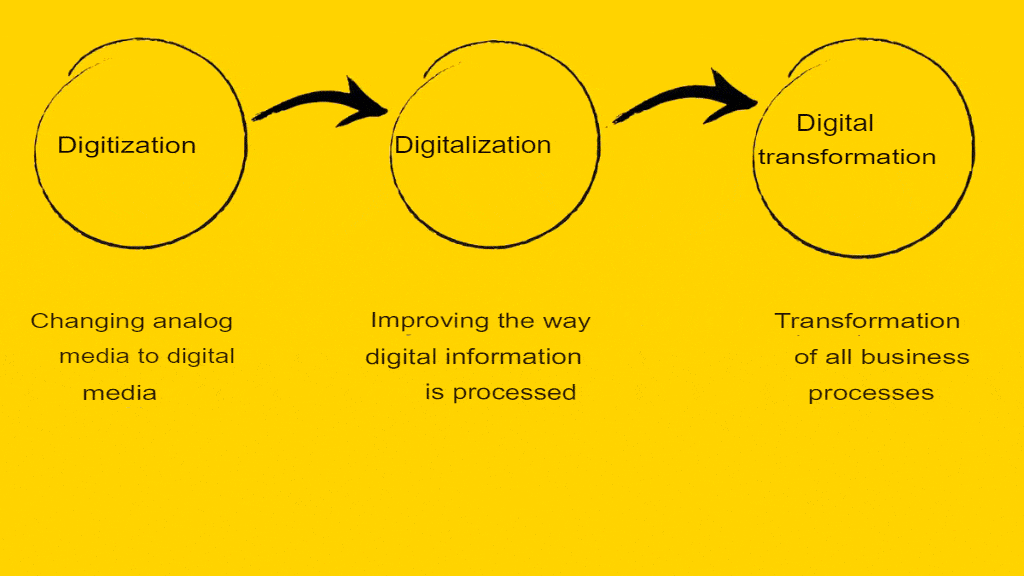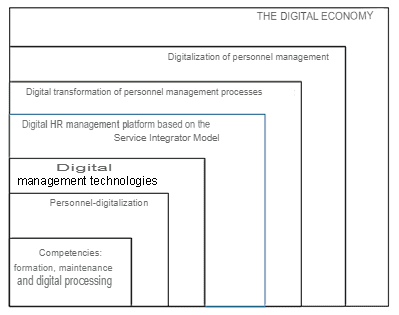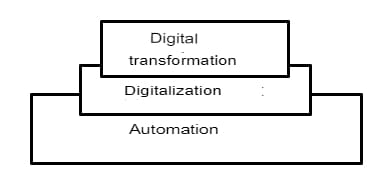–еферат по теме выпускной работы
—одержание
- Introduction
- 1. Digitalization of personnel management: concept, goals and principles
- 1.1 Digitalization of personnel management: the concept and essence
- 1.2 The goals of digital transformation in the personnel management system
- 1.3 Principles of digitalized personnel management
- 2. The field of application of digital technologies in personnel management
- 2.1 Traditional human resource management system
- 2.2 Digital technologies in the personnel management system
- 3. Stages of digitalization of personnel management
- 3.1 Typology of digitalized personnel management
- Conclusions
- List of sources
Introduction
The relevance of the topic.
The active transition to the digital economy and the rapid development of information technologies actualize the task of organizations to find new models of business management. The formation and development of a digital strategy integrated with business and HR strategies (human resources - human resource management) becomes a necessary condition for ensuring a stable competitive position of an economic entity in the labor market. Personnel management is the most dynamic subsystem of the organization, and a qualitative rethinking of personnel management methods and technologies entails a significant impact on the outcome of the enterprise as a whole.
In foreign literature, the term "digitalization" was first used in 1971 by Professor Vachal, who in his work considered the social consequences of "digitalization of society" and the disadvantages of the transition to electronic computing systems.
Digital transformation is becoming a natural stage in the development of the HR industry. More and more digital tools are being used to improve the efficiency and speed of solving the tasks of hiring, retaining and developing staff. A real revolution is taking place in the field of personnel management Ц "uberization". At the same time, HR digital tools are aimed at improving the efficiency and speed of solving traditional tasks. We are talking about a transparent system of motivation and evaluation of staff, impeccable compliance with the payment of salaries and bonuses, an understandable development system, etc.
Digitalization, automation and robotization have a significant impact on the transformation of the labor market. Innovative technologies change the usual functionality of specialists in each of the professional fields every day. And these tools need to be implemented in business processes.
The purpose and objectives of the study: to study the concept, goals, principles, scope and stages of digitalization of personnel management.
Research methods: analysis of scientific literature, generalization and systematization of data.
1. Digitalization of personnel management: concept, goals and principles
1.1 Digitalization of personnel management: the concept and essence
HeadHunter points to the automation of all processes as one of the main drivers of the digital revolution in HR. This can be the automation of recruiting using ATS (Applicant Tracking System), automation of compensation management or the introduction of modern cloud information systems that improve the efficiency of business activities.
According to a Deloitte study, today about 70% of large and medium-sized global companies have successfully implemented HR analytics solutions. And the report Rabota.ru He showed that 56% of companies in Russia already use HR analytics tools in their work. According to a LinkedIn Global Talent Trends survey, 73% of HR managers consider the implementation of HR analytics a priority for their company in the next five years. The most soughtЦafter areas are optimizing talent management and forecasting staff turnover.

Figure 1 - Technological solutions for HR
Digitalization is a way of translating any kind of information into digital form. Digitalization is aimed at achieving the following goals:
- Improving the quality of the organization's product and services provided;
- Transformation of the environment for the use of goods and services;
- Improving the efficiency of value-added processes;
- Optimization of internal and external communications in the organization.
The achievement of each of these goals is directly related to qualitative and quantitative changes in the personnel management system. Let's present a comparative analysis of the traditional (outdated) and digital HR models (Table 1.1).
| Outdated HR model | Digital HR model |
|---|---|
| Processes and transactions | Integrated HR platforms that include management policies, processes, operations and systems |
| Systems in web browsers | Mobile applications |
| Paper documentation and its electronic version | Digital design |
| Process-oriented design | Human-oriented design |
| Service Level Agreement and its time | Real time |
| Service centers | Operational centers |
| Periodic reports | Real-time operational reports |
| Analytical additions | Integrated analytical platforms and consoles |
1.2 The goals of digital transformation in the personnel management system
In the scientific literature, some authors hold a similar point of view to the definition of digital transformation. Thus, L. I. Karpenko and A. B. Belsky define digital transformation as "the process of forming a new type of economy Ц the information economy, carried out through a radical transformation of business processes in all spheres of public life and the formation of sustainable socio-economic development based on the use of modern digital technologies" [3, p. 15]. At the same time, the importance of such an indicator as labor productivity is emphasized.
By "digital transformation", A.D. Korol and Yu. I. Vorotnitsky understand the modernization and optimization of operational processes in various fields of activity of the region, industry, organization based on the use of modern information technologies in order to increase efficiency and competitiveness [4].
Current trends in increasing the role of digital technologies allow us to conclude that the main role in the process of digital transformation is assigned to human resources. The emphasis on the human resources of an individual employee, his competence corresponds to a rationalistic approach to personnel management in order to maximize labor productivity [5, p. 11].
At the same time, digital transformations have led to a rethinking of human resource management functions at the operational and strategic levels. Thus, the use of digital technologies in the personnel management system is a necessary condition for ensuring the future competitiveness and investment attractiveness of the organization through its transformation from traditional to technological.
The process of digital transformations in the field of human resource management is becoming a priority for organizations, since in ensuring competitiveness, the dominant role is assigned to personnel, the bearer of the ability to perceive innovations related to digital changes, as well as as the main source and generator of ideas.

Figure 2 - Stages of HR digitalization (animation: 5 frames, 5 repetition cycles, 62 kilobytes)
The field of application of digital technologies in human resource management is currently at the stage of formation and development, which does not allow for an objective and in-depth analysis. It is obvious that digital technologies in the human resource management system can be applied to any business process, such technologies are of particular importance when searching, hiring, adapting, encouraging and training employees of an organization.
The traditional human resource management system at the present stage includes, as a rule, several fundamental subsystems that specialize in the implementation of a number of specific functions:
- Subsystem of general and linear personnel management;
- The subsystem of personnel assessment;
- Personnel marketing;
- Subsystem of accounting and economic planning;
- Subsystem of management of organizational relations;
- Subsystem of personnel development and training;
- ѕодсистема обеспечени€ прав в системе управлени€ персоналом.
Digitalized personnel management is understood as the paradigm of human capital management, which involves the formation of a proactive information and digital space for the effective use of labor, experience and talents of employees.
The goals of digital transformation in the personnel management system are presented in Table 1.2.
| Goals | Content |
|---|---|
| Improving the competitiveness of enterprise services by optimizing personnel management | Launching new services using digital technologies Transition to new business models using digital technologies |
| Improving the quality of staff business decisions | Collecting new data and converting existing ones into digital format, implementing analytics tools |
| Application of digital HR management platforms | Implementation of digital digital technologies Formation of digital data processing based on a competence-based approach |
| Increasing the level of "viability" of personnel management in a digital format | Digital, cultural, organizational and often operational transformations for a qualitative change in personnel management availability of modern IT tools |
1.3 Principles of digitalized personnel management
Digitalized personnel management is characterized by the following principles:
- Flexible approach to staff development;
- Hyper subordination to the goals of the organization;
- Integration of management into the overall management system;
- Proactive motivation;
- The staff is seen as an investment that needs to be developed;
- The prevalence of potential in recruitment;
- The predominance of working groups and project teams over traditional structural units;
- Proactive innovative role;
- Stimulating change.
2. The field of application of digital technologies in personnel management
2.1 Traditional human resource management system
The development of personnel management in the context of digital transformations is constrained by a number of factors, which include:
- Historical and cultural (multinational; lack of experience and lack of consistency in personnel management);
- Economic (insufficient funds for the introduction of digital technologies; wage differentiation);
- Administrative (authoritarian management style; lack or absence of long-term development plans and strategies).
2.2 Digital technologies in the personnel management system
The digitalization of personnel management encompasses various areas, starting from the management of basic business processes and ending with the formation of new models of the decision-making system and interaction with personnel.

Figure 3 - Typology of digitalized personnel management
3. Stages of digitalization of personnel management
3.1 Typology of digitalized personnel management
In general, the stages of digitalization in personnel management can be presented in the following form (Fig. 4).

Figure 4 - Stages of digitalization in personnel management
Conclusions
Thus, digital technologies or digital technologies are technologies used digitally to optimize the activities of personnel in the field of planning and recruitment, its use, development, evaluation and motivation. The following principles are typical for personnel management in the context of digital transformations:
- Flexible approach to staff development;
- Hyper subordination to the goals of the organization;
- Integration of management into the overall management system;
- Proactive motivation;
- The staff is seen as an investment that needs to be developed;
- The prevalence of potential in recruitment;
- The predominance of working groups and project teams over traditional structural units;
- Proactive innovative role;
- Stimulating change.
The development of personnel management in such conditions is hindered by a number of factors: historical, cultural, economic and administrative.
List of sources
- Automation of the personnel service of the enterprise. (In russian) Ц URL: https://cyberleninka.ru/article/n/avtomatizatsiya-deyatelnosti-kadrovoy-sluzhby-malogo-predpriyatiya (date of application: 14.05.2022).
- Afletunova, G.E. Personnel management system / G.E. Aflyatunova // Infrastructure sectors of the economy: problems and prospects of development. ? 2015. ? No. 8. ? pp. 93-97.
- Bazarov, T.Y. Personnel management: a textbook / T.Y. Bazarov. ? Moscow: Academy, 2013. ? 354 p.
- Belov, S.V. Safety of production processes / S.V. Belov // Handbook, Moscow: Mashinostroenie, 2015. Ц 615 p .
- Berestova, L.I. Modern approaches to personnel management in market conditions / L.I. Berestova // Public Service. ? 2013. ? є 3 (83). ? Pp. 33-34.
- Bondar, I.G. Effective management of the firm: modern theory and practice / I.G. Bondar [et al.]. Ц St. Petersburg: Dom Business-Press, 2015. Ц 416 p.
- Boriskin, V. V. Personnel of the enterprise / V. V. Boriskin. Ц Moscow: IPK of civil service, 2014. Ц 293 p.
- Busygina, E.V. Features of personnel management in the service sector / E.V. Busygina // Modern scientific research and innovation. ? 2015. ? є 11 (55). ? Pp. 579-581.
- Denisenko, G.F. Labor protection: studies. manual for eng.-econ. spec. universities / G.F. Denisenko. Ц Moscow: Higher School, 2015. Ц 319 p.
- Zakharkina, O. I. Personnel service of the enterprise: office work, document management and regulatory framework / O. I. Zakharkina. Ц "Omega-L", 2017. Ц 218 p.
- Personnel security as one of the components of the economic security of the organization. Ц URL: https://cyberleninka.ru/article/n/kadrovaya-bezopasnost-kak-odna-iz-sostavlyayuschih-ekonomicheskoy-bezopasnosti-organizatsii/viewer (date of application: 15.05.2022).
- Karpov, Yu.V. Protection from noise and vibration at chemical industry enterprises / Yu.V. Karpov, L.A. Dvoryantseva. Ц Moscow: Chemistry, 2010. Ц 120 p.
- Kovalevsky, S. Head and subordinate / S. Kovalevsky. Ц Moscow: Progress, 2013. Ц pp. 25-54.
- Kunz, R.O. Management. System and situational analysis of managerial functions. Vol. 1. / R.O. Kunts, S. Donnell; trans. from English Ц Moscow: Progress, 2018. Ц pp.78-104.
- Maltseva, T.I. Personnel management system of an educational institution / T.I. Maltseva // Problems and prospects of education development: materials of the II International Scientific Conference Ц Perm: Mercury, 2012. Ц pp. 43-44.
- Makhovikova, G. A. Economic theory: textbook and workshop for universities / G. A. Makhovikova, G. M. Ghukasyan, V. V. Amosova. Ц 4th ed., reprint. and additional Ц Moscow: Yurayt Publishing House, 2020. Ц 443 p.
- Mondi, U.R. Personnel Management / Wayne R. Mondi, M. Know Robert, R. Premo Shane; translated from English; edited by I.V. Andreeva, S.V. Kosheleva. Ц St. Petersburg: Neva, 2014. Ц 640 p.
- Paytayeva, K.T. Efficiency of personnel management of an enterprise in a crisis / K.T. Paytayeva // New science: Theoretical and practical view. ? 2016. ? є 2-1 (63). ? Pp. 113-116.
- Papanova, O.A. Modern approach to personnel management / O.A. Papanova // APRIORI. Series: Humanities. ? 2015. ? No. 3. ? p. 48.
- Transition to electronic personnel documents. Ц URL: https://cyberleninka.ru/article/n/perehod-na-elektronnye-kadrovye-dokumenty-realii-i-perspektivy/viewer (date of application: 15.05.2022).
- Polyakova, R.T. Features of personnel management in the chain restaurant business / R.T. Polyakova // In the collection: cost-effective and environmentally friendly innovative technologies. Proceedings of the second International Scientific and Practical Conference. ? 2016. ? pp. 103-119.
- Saveliev, D.A. Modern criteria for evaluating the effectiveness of the company's personnel / D.A. Saveliev // Issues of regional economy. ? 2015. ? No. 2. ? pp. 38-44.
- Samoylyuk, T.A. Application of a system of balanced indicators for evaluating the effectiveness of personnel management / T.A. Samoylyuk // Interexpo Geo-Siberia. ? 2015. ? No. 2. ? pp. 151-155.
- Santalova, M.S. Innovative approach to personnel management and evaluation / M.S. Santalova, S.S. Didenko // European Social Science Journal. ? 2015. ? є 1-2 (52). ? Pp. 86-90.
- Simonov, V.P. Pedagogical management: Know-how in education: studies. manual / V.P. Simonov. ? Moscow: Higher education; Yurayt, 2009. Ц 357 p.
- Tools protect Apostille in mechanical engineering: computation and Design: Directory / s. V. Belov, A. F. Kozyakov, Oh. F. Partholin etc.; in order. S. V. Belova. - Moscow: Mechanical Engineering, 1989. - 368 pp.
- Tretyakov, P.And. Adaptive management pedagogical systems: ucheb. P.And. Tretyakov, S.N. Mitin, N.N. Boyarintseva; under order. P.And. Tretiakova. ? Moscow: Academy, 2016. - 368 pp.
- Personnel management of the organization: textbook for bachelors / N. A. Alexandrova, L. I. Vasiltsova, B. A. Voronin, V. I. Nabokov. Ц Yekaterinburg: Ural. agrarian publishing house, 2013. Ц 372 p.
- Fionova, L. R. Competent document management is the basis of effective management / L. R. Fionova // Theory and practice of social development: International scientific journal / ch. ed. V. L. Kharseeva. Ц Krasnodar: HORSE, 2014. Ц No. 6. Ц 350 p.
- Tsvetaeva, V. M. Personnel management / V. M. Tsvetaeva. Ц St. Petersburg: Peter, 2012. Ц 392 p.
- Shamova, T. I. Management of educational systems: studies. manual for students. higher. studies. institutions / T. I. Shamova, T. M. Davydenko, G. N. Shibanova; edited by T. I. Shamova. ? 4th ed., erased. ? Moscow: Publishing Center "Academy", 2007. ? 384 p.
- Yudin, E.Ya. Labor protection in mechanical engineering: textbook. manual for engineering universities / E.Ya. Yudin, S.V. Belov. Ц 2nd ed., reprint. and additional Ц Moscow: Mashinostroenie, 2013. Ц 432 p.
- HR AiT. Personnel management. Ц URL: https://hr-portal.ru/article/analiz-sistemy-upravleniya-personalom-celi-i-metody (date of application: 14.05.2022).
